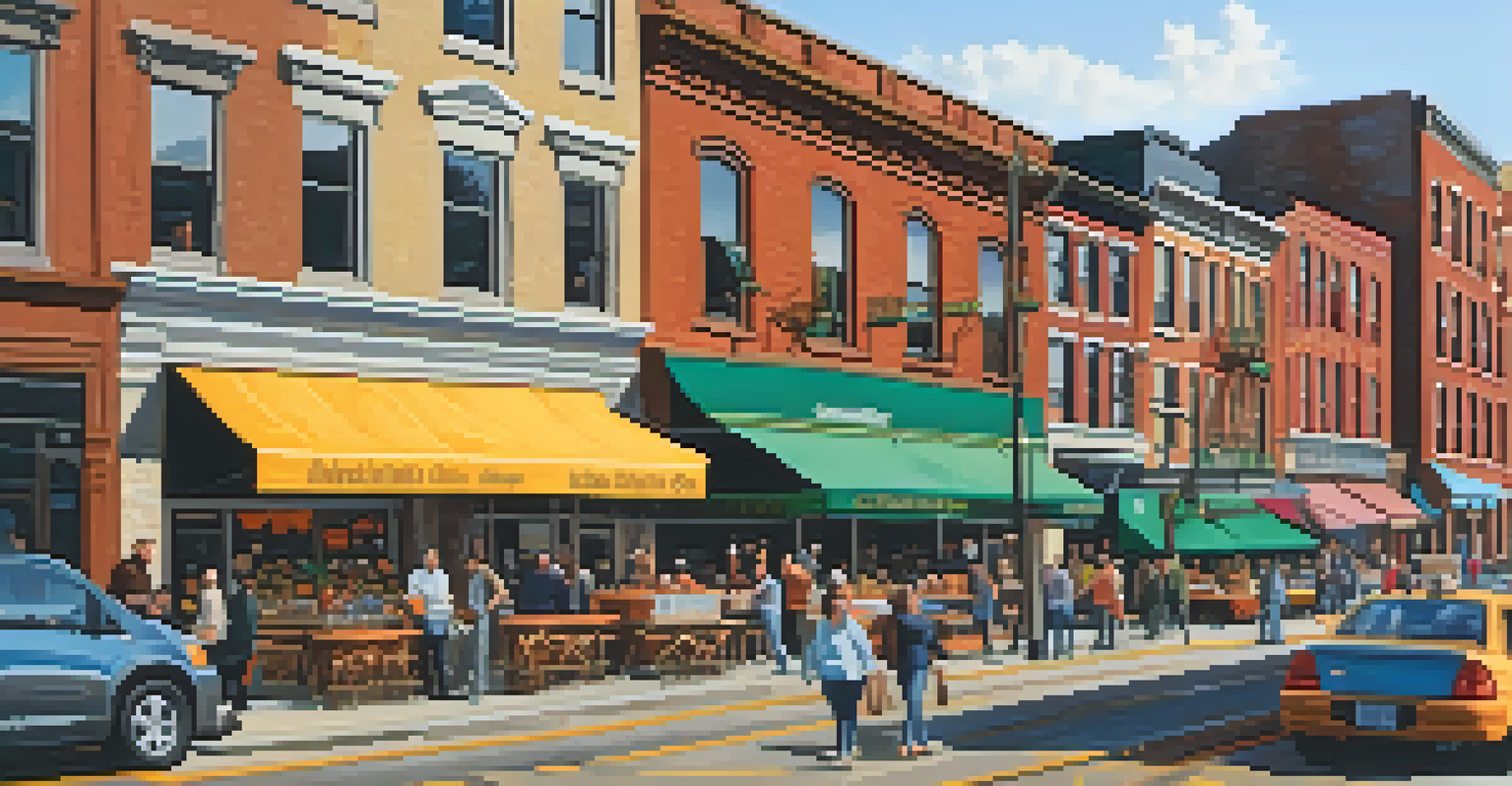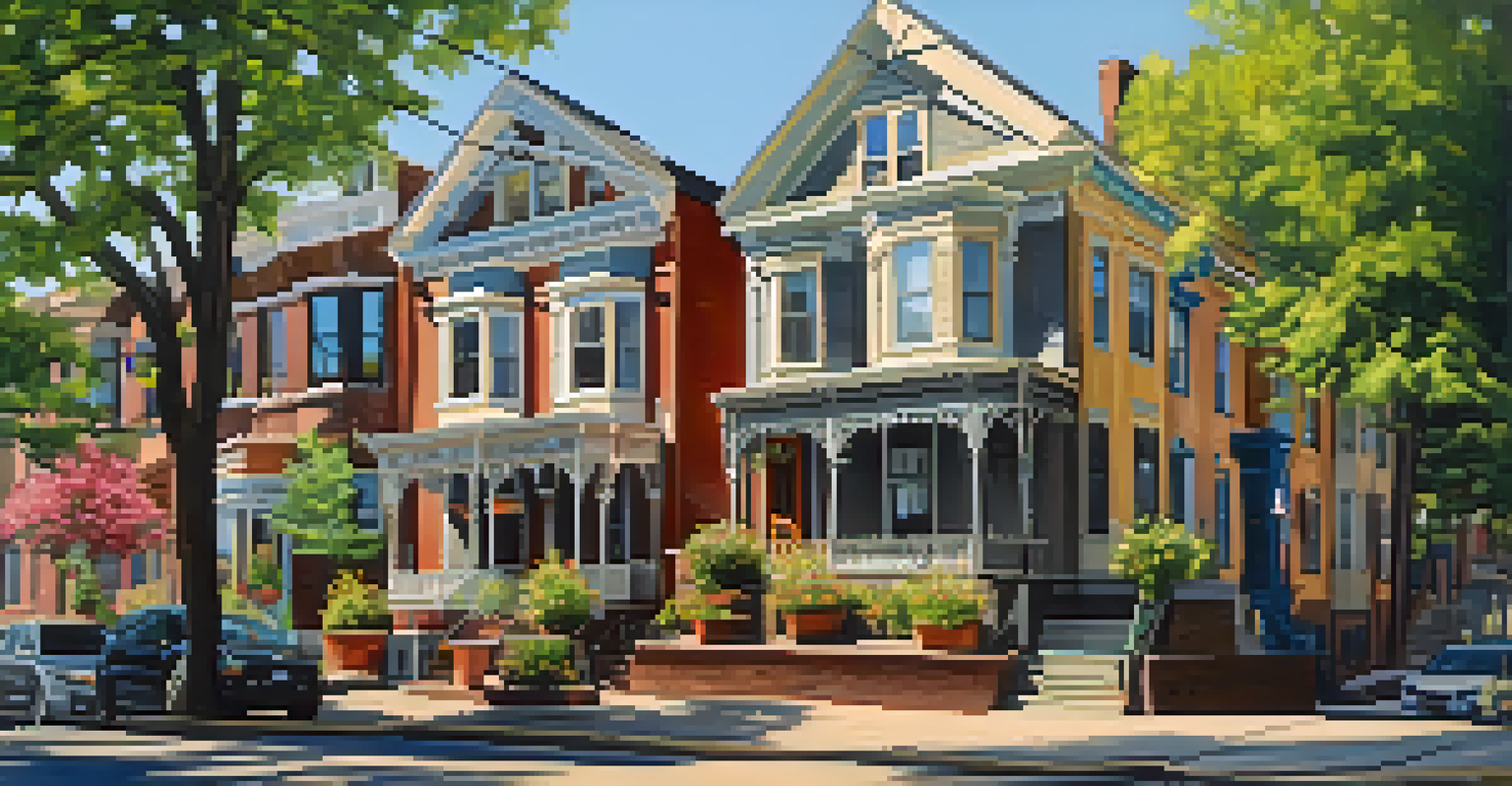Pittsburgh's Urban Planning: Lessons from Architectural Heritage

The Evolution of Pittsburgh's Urban Landscape
Pittsburgh's urban landscape has undergone significant transformations over the decades, reflecting its rich history. From its industrial roots to its current revitalization, the city's architecture tells a story of resilience and adaptation. Each era’s design choices have left an indelible mark, creating a unique blend of styles that characterize the city today.
Preservation of our heritage is not a matter of preserving the past, but of building the future.
Consider the iconic PPG Place, with its glass façade that speaks to modernity, juxtaposed against the historic Allegheny County Courthouse, showcasing stunning Gothic Revival architecture. This contrast in styles not only highlights Pittsburgh's architectural diversity but also serves as a lesson in maintaining historical integrity while embracing innovation.
As we explore these architectural shifts, it becomes clear that understanding this evolution is crucial for future urban planning. By acknowledging the past, city planners can make informed decisions that honor the city's heritage while paving the way for sustainable growth.
Architectural Heritage as a Catalyst for Urban Renewal
Pittsburgh’s architectural heritage plays a pivotal role in its urban renewal efforts. Historical buildings, when preserved, provide a sense of identity and continuity for communities. They often become focal points in revitalization projects, drawing both locals and tourists, which stimulates economic growth.

For instance, the restoration of the Strip District has transformed it into a vibrant hub of activity, filled with shops, eateries, and markets, all while retaining its historic charm. This approach not only enhances the aesthetic appeal but also fosters community engagement and pride.
Pittsburgh's Architectural Evolution
The city's architectural evolution reflects its rich history, showcasing a blend of styles that inform future urban planning.
Utilizing architectural heritage as a foundation for urban renewal is a strategy that enhances livability. It encourages a unique blend of old and new, making Pittsburgh an inviting place that celebrates its history while looking toward the future.
Lessons from Pittsburgh’s Historic Neighborhoods
The city’s historic neighborhoods, such as Lawrenceville and Squirrel Hill, offer valuable lessons in community planning. These areas demonstrate how preserving character and charm can lead to cohesive community development. The unique architectural features in these neighborhoods create a sense of belonging and identity among residents.
The greatest cities are not defined by their height, but by their breadth of vision.
Take a stroll through Lawrenceville, where Victorian homes stand shoulder to shoulder with contemporary boutiques and cafés. This blend of old and new not only attracts diverse residents but also fosters a vibrant local economy. It’s a testament to how thoughtful urban planning can enhance community dynamics.
By studying these neighborhoods, urban planners can identify the elements that make spaces inviting and functional. Emphasizing heritage while accommodating modern needs can create thriving, interconnected communities.
Preservation vs. Modernization: Finding a Balance
One of the most significant challenges in urban planning is striking a balance between preservation and modernization. Cities like Pittsburgh face the ongoing dilemma of whether to maintain historic structures or make way for new developments. This tug-of-war can create tension among residents, planners, and developers.
Pittsburgh has made strides in addressing this issue by implementing policies that encourage adaptive reuse. This means repurposing old buildings for new functions, which not only preserves history but also minimizes waste and supports sustainability. An example can be seen in the transformation of the old Nabisco factory into a mixed-use development.
Heritage Fuels Urban Renewal
Preserving architectural heritage enhances community identity and drives economic growth through revitalization efforts.
Finding this balance is crucial for maintaining the city’s character while accommodating growth. It requires open dialogue among stakeholders to ensure that both heritage and progress are prioritized.
The Role of Community Input in Urban Planning
Community input is essential in the urban planning process, especially when it comes to preserving architectural heritage. Engaging residents in discussions about their neighborhoods allows planners to understand the values and needs of the community. This participatory approach fosters a sense of ownership and responsibility among residents.
For example, the city of Pittsburgh has hosted workshops and forums encouraging public feedback on new developments. This inclusive strategy not only builds trust but also leads to more successful urban planning outcomes. When people feel heard, they are more likely to support and engage with planning initiatives.
Incorporating community voices into planning ensures that developments align with the community's historical context and aspirations. This collaboration ultimately leads to more vibrant and cohesive urban spaces.
Sustainability and Architectural Heritage: A Symbiotic Relationship
Sustainability is becoming an increasingly crucial aspect of urban planning, and it often intersects with architectural heritage. By preserving historic buildings, cities like Pittsburgh can reduce environmental impact, as existing structures require fewer resources to maintain than new constructions. This approach aligns with sustainable development goals.
Moreover, many historic buildings are designed to be energy-efficient, with features like thick walls and strategically placed windows for natural light. Integrating these elements into modern designs can promote sustainability while respecting the past. Acknowledging these attributes can guide planners in creating eco-friendly developments.
Community Input Shapes Planning
Engaging residents in urban planning fosters a sense of ownership and leads to more successful and vibrant developments.
The symbiotic relationship between sustainability and architectural heritage encourages a holistic approach to urban planning. By valuing both, cities can create resilient environments that honor history while promoting a sustainable future.
Pittsburgh as a Model for Future Urban Planning
As urban planners look to the future, Pittsburgh serves as an exemplary model for integrating architectural heritage into modern development. The city’s unique blend of historical preservation and innovative design showcases the potential for sustainable urban growth. Other cities can learn from Pittsburgh’s approach to balancing these elements.
By prioritizing community engagement, sustainable practices, and the preservation of cultural identity, urban planners can create spaces that thrive. Pittsburgh's success stories demonstrate that cities can evolve without losing their character. This is not just about buildings but about fostering communities and enhancing quality of life.

As we move forward, embracing the lessons from Pittsburgh’s architectural heritage can lead to vibrant, sustainable urban environments. Cities that learn from these experiences will be better equipped to face the challenges of modern urbanization.